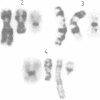Abstract
A new dicentric X isochromosome i(X)(pter to q2102 to pter) of similar size to a normal X is described in a girl with gonadal dysgenesis. In this non-mosaic case with an X short arm duplication, most of the stigmata associated with Turner's syndrome were absent. This structure was compared with that of six i(Xq) and three del(X). The del(Xq) structures all possessed a regular sized C band, but in the i(Xq) this was double sized in each case. Phenotypic comparisons are made in the Xq deletions, and some presumptive short arm isochromosomes are reinterpreted as Xq deletions. Incomplete centromeric suppression is suggested as the causal mechanism of mosaicism of sex isochromosomes with 45,X cells, and it is argued that an exchange event between homologoues is an unlikely mechanism to explain sex isochromosome origin.
Full text
PDF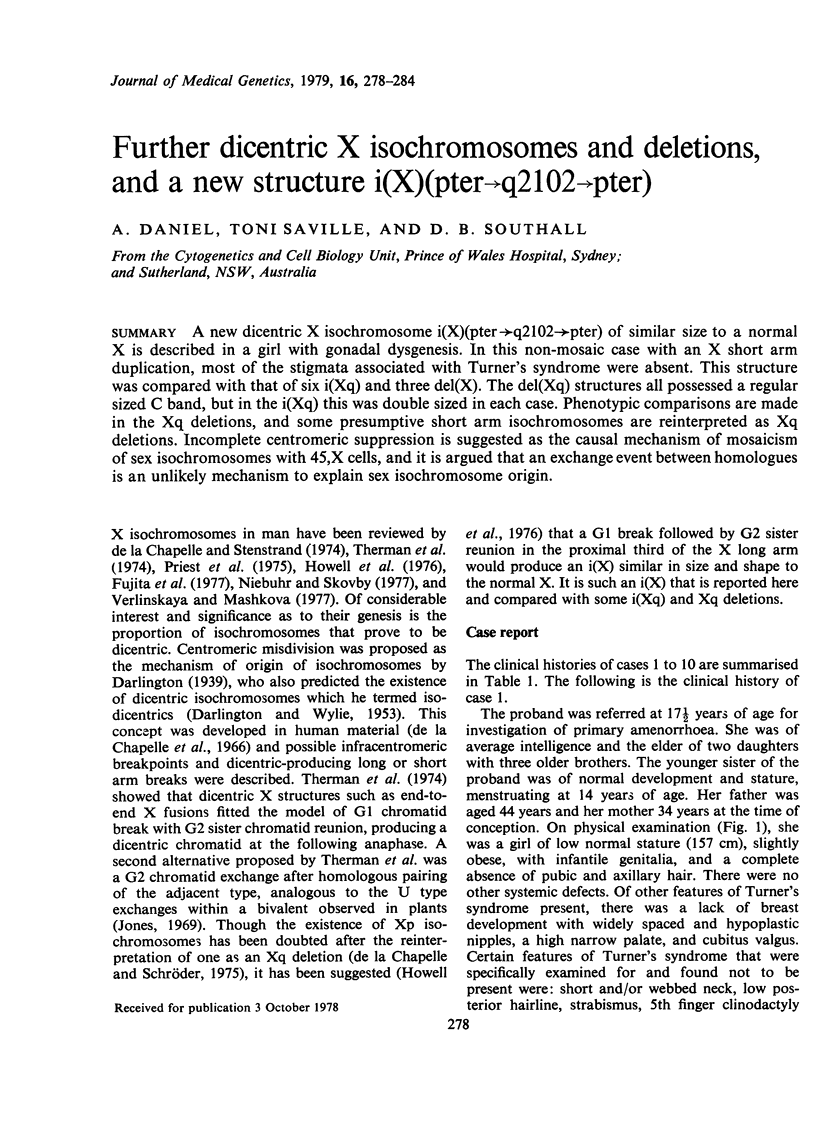
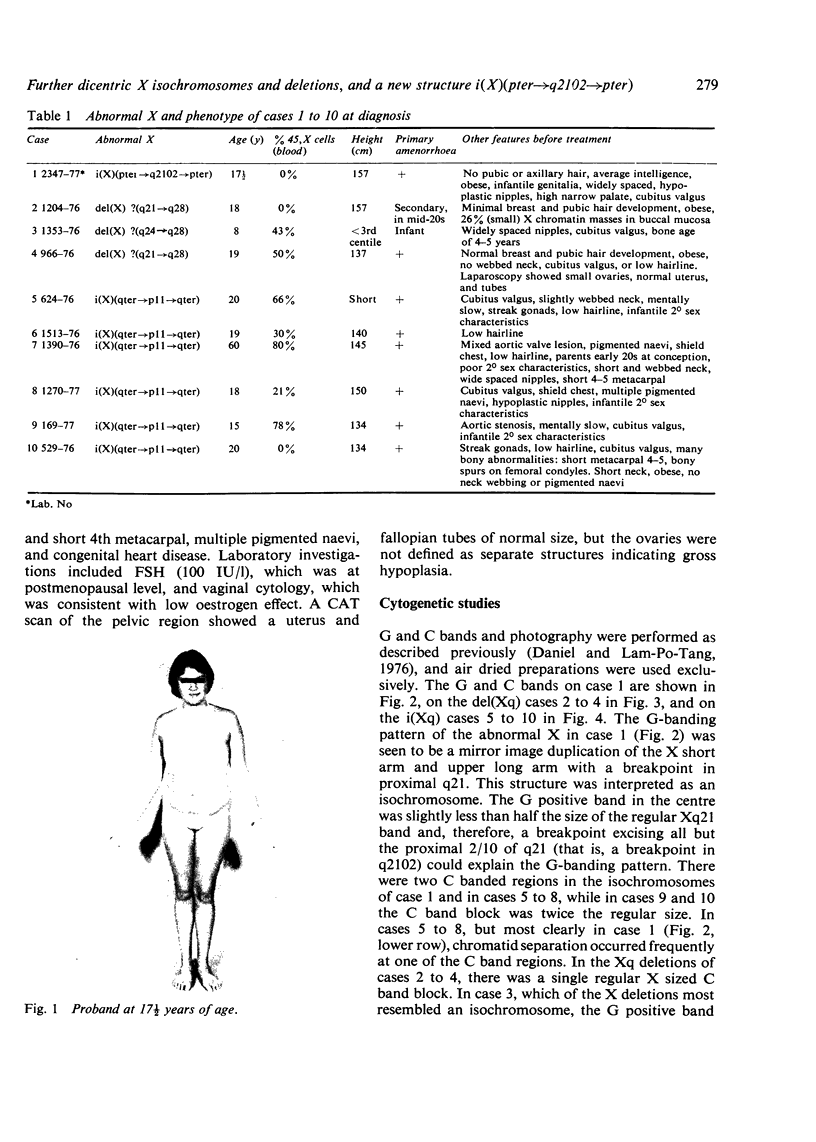
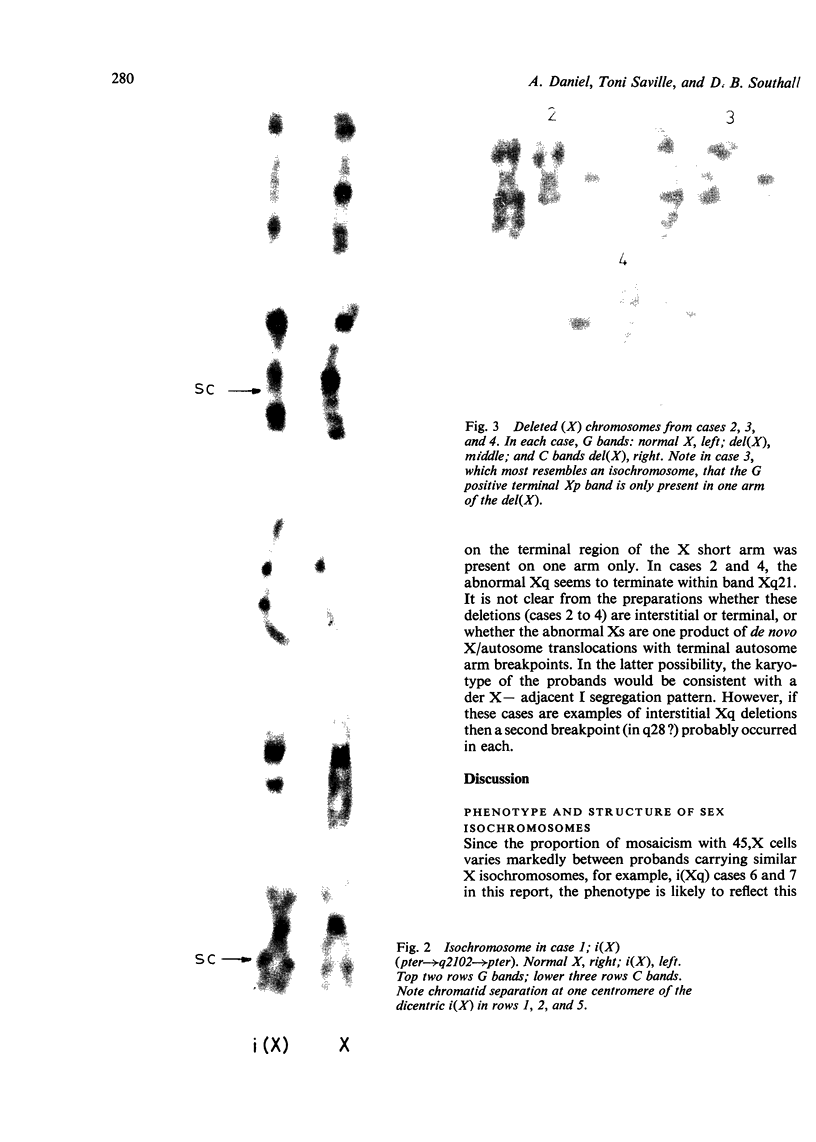
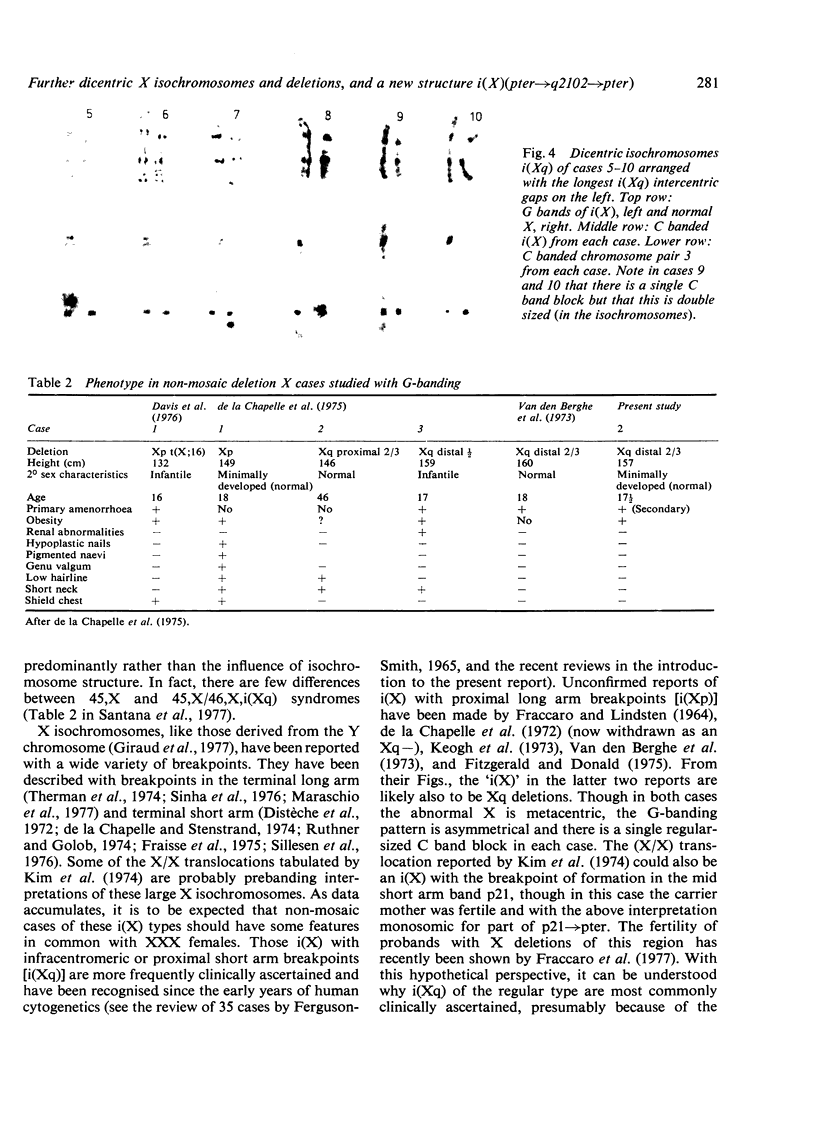
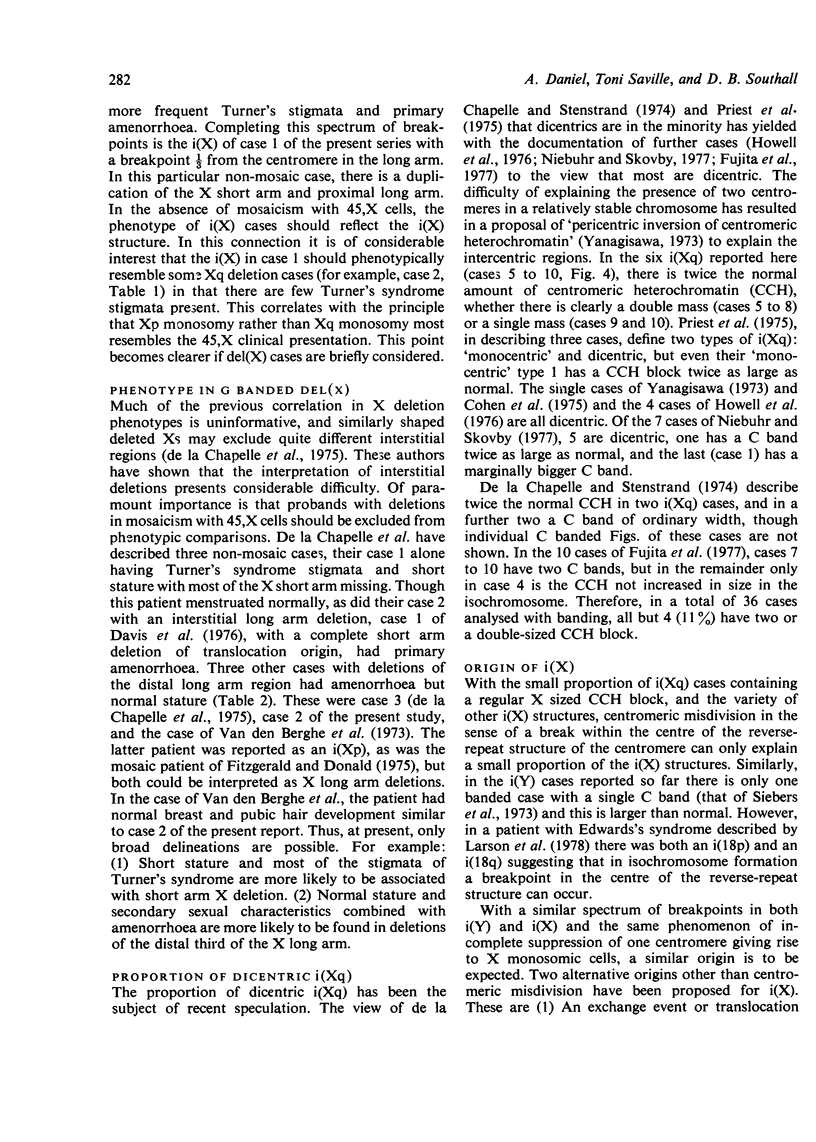
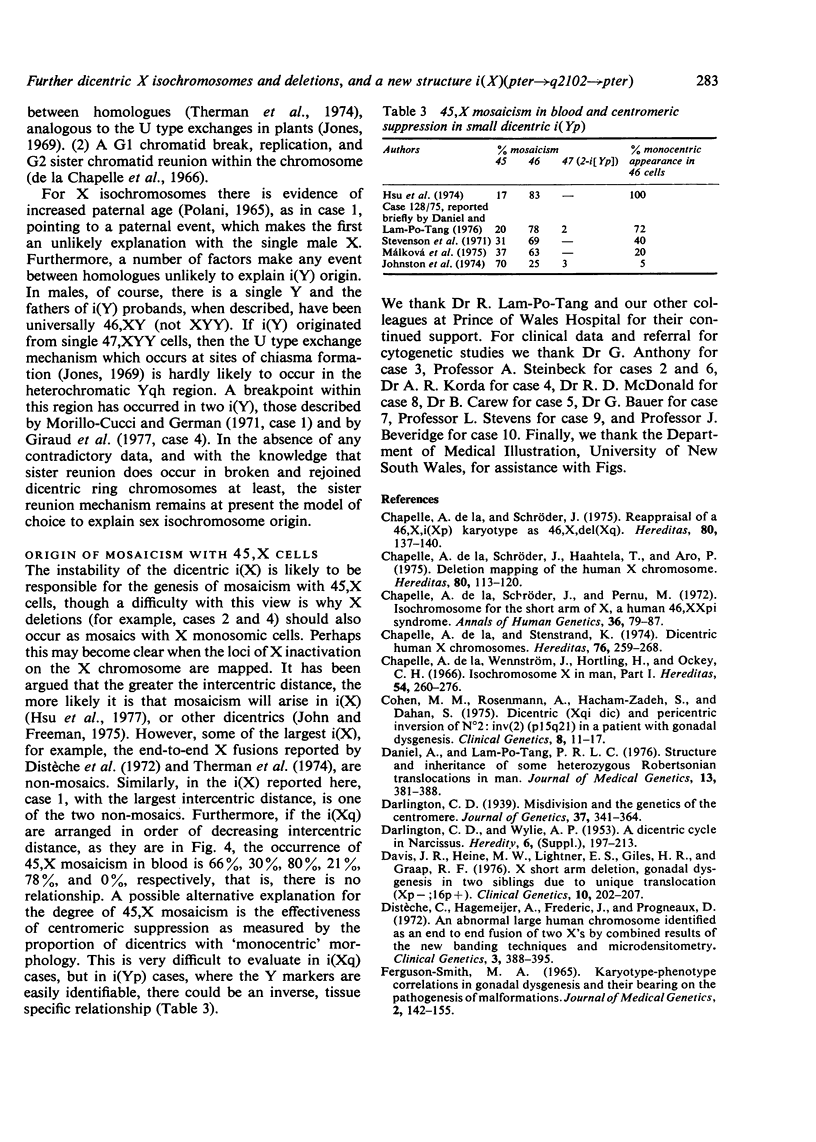
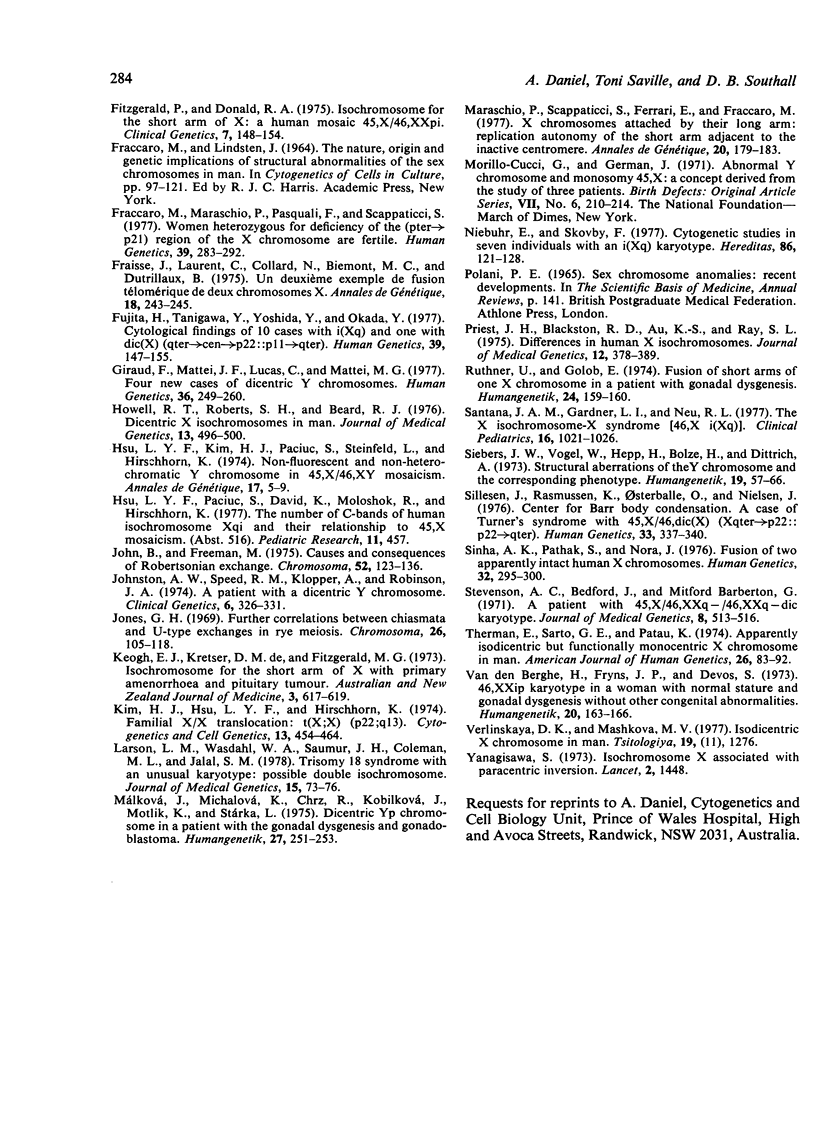
Images in this article
Selected References
These references are in PubMed. This may not be the complete list of references from this article.
- Cohen M. M., Rosenmann A., Hacham-Zadeh S., Dahan S. Dicentric X-isochromosome (Xqi dic) and pericentric inversion of No. 2 [inv(2) (p15 q21)] in a patient with gonadal dysgenesis. Clin Genet. 1975 Jul;8(1):11–17. doi: 10.1111/j.1399-0004.1975.tb01948.x. [DOI] [PubMed] [Google Scholar]
- Daniel A., Lam-Po-Tang P. R. Structure and inheritance of some heterozygous Robertsonian translocation in man. J Med Genet. 1976 Oct;13(5):381–388. doi: 10.1136/jmg.13.5.381. [DOI] [PMC free article] [PubMed] [Google Scholar]
- Davis J. R., Heine M. W., Lightner E. S., GILES H. R., Graap R. F. X-short arm deletion gonadal dysgenesis in two siblings due to unique translocation (Xp-;16p+). Clin Genet. 1976 Oct;10(4):202–207. doi: 10.1111/j.1399-0004.1976.tb00034.x. [DOI] [PubMed] [Google Scholar]
- De la Chapelle A., Schröder J., Pernu M. Isochromosome for the short arm of X, a human 46, XXpi syndrome. Ann Hum Genet. 1972 Jul;36(1):79–87. doi: 10.1111/j.1469-1809.1972.tb00583.x. [DOI] [PubMed] [Google Scholar]
- De la Chapelle A., Stenstrand K. Dicentric human X chromosomes. Hereditas. 1974;76(2):259–268. doi: 10.1111/j.1601-5223.1974.tb01344.x. [DOI] [PubMed] [Google Scholar]
- De la Chapelle A., Wennström J., Hortling H., Ockey C. H. Isochromosome-X in man. I. Hereditas. 1966;54(3):260–276. doi: 10.1111/j.1601-5223.1966.tb02021.x. [DOI] [PubMed] [Google Scholar]
- Distèche C., Hagemeijer A., Frederic J., Progneaux D. An abnormal large human chromosome identified as an end-to-end fusion of two X's by combined results of the new banding techniques and microdensitometry. Clin Genet. 1972;3(5):388–395. doi: 10.1111/j.1399-0004.1972.tb01472.x. [DOI] [PubMed] [Google Scholar]
- FERGUSON-SMITH M. A. KARYOTYPE-PHENOTYPE CORRELATIONS IN GONADAL DYSGENESIS AND THEIR BEARING ON THE PATHOGENESIS OF MALFORMATIONS. J Med Genet. 1965 Jun;2(2):142–155. doi: 10.1136/jmg.2.2.142. [DOI] [PMC free article] [PubMed] [Google Scholar]
- Fitzgerald P. H., Donald R. A. Isochromosome for the short arm of X: a human mosaic 45,x/46,XXpi. Clin Genet. 1975 Feb;7(2):148–154. doi: 10.1111/j.1399-0004.1975.tb00311.x. [DOI] [PubMed] [Google Scholar]
- Fraccaro M., Maraschio P., Pasquali F., Scappaticci S. Women heterozygous for deficiency of the (p21 leads to pter) region of the X chromosome are fertile. Hum Genet. 1977 Dec 23;39(3):283–292. doi: 10.1007/BF00295421. [DOI] [PubMed] [Google Scholar]
- Fraisse J., Laurent C., Collard N., Biemont M. C., Dutrillaux B. Un deuxième exemple de fusion télomérique de deux chromosomes X. Ann Genet. 1975 Dec;18(4):243–245. [PubMed] [Google Scholar]
- Fujita H., Tanigawa Y., Yoshida Y., Okada Y. Cytological findings of 10 cases with i(Xq) and one with dic(X)(qter leads to cen leads to p22::p11 leads to qter). Hum Genet. 1977 Nov 10;39(2):147–155. doi: 10.1007/BF00287006. [DOI] [PubMed] [Google Scholar]
- Giraud F., Mattei J. F., Lucas C., Mattei M. G. Four new cases of Dicentric Y chromosomes. Hum Genet. 1977 May 10;36(3):249–260. doi: 10.1007/BF00446273. [DOI] [PubMed] [Google Scholar]
- Howell R. T., Roberts S. H., Beard R. J. Dicentric X isochromosomes in man. J Med Genet. 1976 Dec;13(6):496–500. doi: 10.1136/jmg.13.6.496. [DOI] [PMC free article] [PubMed] [Google Scholar]
- Hsu L. Y., Kim H. J., Paciuc S., Steinfeld L., HirshhorHirschhorn K. Non-fluorescent and non-heterochromatic Y chromosome in 45, X 46,XY mosaicism. Ann Genet. 1974 Mar;17(1):5–9. [PubMed] [Google Scholar]
- John B., Freeman M. Causes and consequences of Robertsonian exchange. Chromosoma. 1975 Sep 26;52(2):123–136. doi: 10.1007/BF00326262. [DOI] [PubMed] [Google Scholar]
- Johnston A. W., Speed R. M., Klopper A., Robinson J. A. A patient with a dicentric Y chromosome. Clin Genet. 1974;6(4):326–331. doi: 10.1111/j.1399-0004.1974.tb02094.x. [DOI] [PubMed] [Google Scholar]
- Keogh E. J., De Kretser D. M., Fitzgerald M. G. Isochromosome for the short arm of X with primary amenorrhoea and a pituitary tumour. Aust N Z J Med. 1973 Dec;3(6):617–619. doi: 10.1111/j.1445-5994.1973.tb04305.x. [DOI] [PubMed] [Google Scholar]
- Kim H. J., Hsu L. Y., Hirschhorn K. Familial x/x translocation: t(x;x)(p22;q13) Cytogenet Cell Genet. 1974;13(5):454–464. doi: 10.1159/000130299. [DOI] [PubMed] [Google Scholar]
- Larson L. M., Wasdahl W. A., Saumur J. H., Coleman M. L., Jalal S. M. Trisomy 18 syndrome with an unusual karyotype: possible double isochromosome. J Med Genet. 1978 Feb;15(1):73–76. doi: 10.1136/jmg.15.1.73. [DOI] [PMC free article] [PubMed] [Google Scholar]
- Maraschio P., Scappaticci S., Ferrari E., Fraccaro M. X chromosomes attached by their long arm: replication autonomy of the short arm adjacent to the inactive centromere. Ann Genet. 1977 Sep;20(3):179–183. [PubMed] [Google Scholar]
- Morillo-Cucci G., German J. Abnormal Y chromosomes and monosomy 45,X: a concept derived from the study of three patients. Birth Defects Orig Artic Ser. 1971 May;7(6):210–214. [PubMed] [Google Scholar]
- Málková J., Michalová K., Chrz R., Kobilková J., Motlík K., Stárka L. Dicentric Yp chromosome in a patient with the gonadal dysgenesis and gonadoblastoma. Humangenetik. 1975;27(3):251–253. doi: 10.1007/BF00278354. [DOI] [PubMed] [Google Scholar]
- Niebuhr E., Skovby F. Cytogenetic studies in seven individuals with an i(Xq) karyotype. Hereditas. 1977;86(1):121–128. doi: 10.1111/j.1601-5223.1977.tb01220.x. [DOI] [PubMed] [Google Scholar]
- Polani P. E. Sex-chromosome anomalies: recent developments. Sci Basis Med Annu Rev. 1965:141–163. [PubMed] [Google Scholar]
- Priest J. H., Blackston R. D., Au K. S., Ray S. L. Differences in human X isochromosomes. J Med Genet. 1975 Dec;12(4):378–389. doi: 10.1136/jmg.12.4.378. [DOI] [PMC free article] [PubMed] [Google Scholar]
- Ruthner U., Golob E. Fusion of the short arms of one X chromosome in a patient with gonadal dysgenesis. Humangenetik. 1974;24(2):159–160. doi: 10.1007/BF00283775. [DOI] [PubMed] [Google Scholar]
- Santana J. A., Gardner L. I., Neu R. L. The X isochromosome-X syndrome [46,X,i(Xq)]. Report of three cases with review of the phenotype. Clin Pediatr (Phila) 1977 Nov;16(11):1021–1026. doi: 10.1177/000992287701601112. [DOI] [PubMed] [Google Scholar]
- Siebers J. W., Vogel W., Hepp H., Bolze H., Dittrich A. Structural aberrations of the Y chromosome and the corresponding phenotype. Report of a case with the karotype 45,X-46,X,i(Yp). Humangenetik. 1973;19(1):57–66. doi: 10.1007/BF00295235. [DOI] [PubMed] [Google Scholar]
- Sillesen I., Rasmussen K., Osterballe O., Nielsen J. Center for Barr body condensation. A case of Turner's syndrome with 45,X/46,X,dic(X) (Xqter leads to p22::p22 leads to qter). Hum Genet. 1976 Aug 30;33(3):337–340. doi: 10.1007/BF00286864. [DOI] [PubMed] [Google Scholar]
- Sinha A. K., Pathak S., Nora J. J. Fusion of two apparently intact human X chromosomes. Hum Genet. 1976 Jun 29;32(3):295–300. doi: 10.1007/BF00295819. [DOI] [PubMed] [Google Scholar]
- Stevenson A. C., Bedford J., Barberton G. M. A patient with 45,X-46,XXq--46,XXq-dic karyotype. J Med Genet. 1971 Dec;8(4):513–516. doi: 10.1136/jmg.8.4.513. [DOI] [PMC free article] [PubMed] [Google Scholar]
- Therman E., Sarto G. E., Patau K. Apparently isodicentric but functionally monocentric X chromosome in man. Am J Hum Genet. 1974 Jan;26(1):83–92. [PMC free article] [PubMed] [Google Scholar]
- Van den Berghe H., Fryns J. P., Devos F. [46, XXip karyotype in a woman with normal stature and gonadal dysgenesis without other congenital anomalies]. Humangenetik. 1973;20(2):163–166. doi: 10.1007/BF00284853. [DOI] [PubMed] [Google Scholar]
- Verlinskaia D. K., Mashkova M. V. Izoditsentricheskie X-khromosomy u cheloveka. Tsitologiia. 1977 Nov;19(11):1276–1278. [PubMed] [Google Scholar]
- Yanagisawa S. Letter: Isochromosome X associated with paracentric inversion. Lancet. 1973 Dec 22;2(7843):1448–1448. doi: 10.1016/s0140-6736(73)92848-1. [DOI] [PubMed] [Google Scholar]
- de la Chapelle A., Schröder J., Haahtela T., Aro P. Deletion mapping of the human X chromosome. Hereditas. 1975;80(1):113–120. doi: 10.1111/j.1601-5223.1975.tb01505.x. [DOI] [PubMed] [Google Scholar]
- de la Chapelle A., Schröder J. Reappraisal of a 46,X,i(Xp) karyotype as 46,X,del(Xg). Hereditas. 1975;80(1):137–140. doi: 10.1111/j.1601-5223.1975.tb01508.x. [DOI] [PubMed] [Google Scholar]





